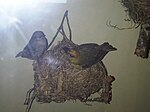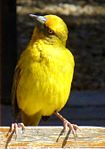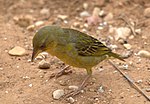en
names in breadcrumbs


Die Kaapse wewer (Ploceus capensis) is 'n endemiese, algemene standvoël in grasveld en bossieveld en is poliginies. Hulle broei gewoonlik koloniaal in riete of hoë bome en maak 'n groot nes met 'n kort ingangstonnel. Die voël is 17 cm groot en weeg 28 - 54 gram. In Engels staan die voël bekend as die Cape Weaver.
Die Kaapse wewer (Ploceus capensis) is 'n endemiese, algemene standvoël in grasveld en bossieveld en is poliginies. Hulle broei gewoonlik koloniaal in riete of hoë bome en maak 'n groot nes met 'n kort ingangstonnel. Die voël is 17 cm groot en weeg 28 - 54 gram. In Engels staan die voël bekend as die Cape Weaver.
'''Ploceus capensis[2] [3] ye una especie d'ave paseriforme de la familia Ploceidae nativa de Sudáfrica. Ye una especie común en pacionales, hábitats agrícoles y fynbos, de cutiu cerca de los ríos. Reproduzse en colonies ruidoses nos árboles (de cutiu sauces o ocalitos, escasamente en palmeres) y cañaverales.
Mide unos 17 cm de llargu. Tien l'envés rayáu d'oliva marrón. El picu ye cónicu y apuntiáu. Los machos reproductores tienen la cabeza y les partes inferiores marielles, la cara de color naranxa y los iris blancos. Les femes adultes tienen la cabeza y el pechu avisiegu de mariellu-oliva, a mariellu pálido na parte baxa del abdome. Los sos güeyos son de color marrón. Les aves nueves son similares a les femes.
Reconócense trés subespecies:[4]
 Esta páxina forma parte del wikiproyeutu Aves, un esfuerciu collaborativu col fin d'ameyorar y organizar tolos conteníos rellacionaos con esti tema. Visita la páxina d'alderique del proyeutu pa collaborar y facer entrugues o suxerencies.
Esta páxina forma parte del wikiproyeutu Aves, un esfuerciu collaborativu col fin d'ameyorar y organizar tolos conteníos rellacionaos con esti tema. Visita la páxina d'alderique del proyeutu pa collaborar y facer entrugues o suxerencies. '''Ploceus capensis ye una especie d'ave paseriforme de la familia Ploceidae nativa de Sudáfrica. Ye una especie común en pacionales, hábitats agrícoles y fynbos, de cutiu cerca de los ríos. Reproduzse en colonies ruidoses nos árboles (de cutiu sauces o ocalitos, escasamente en palmeres) y cañaverales.
Aderyn a rhywogaeth o adar yw Gwehydd y Penrhyn (sy'n enw gwrywaidd; enw lluosog: gwehyddion y Penrhyn) a adnabyddir hefyd gyda'i enw gwyddonol Ploceus capensis; yr enw Saesneg arno yw Cape weaver. Mae'n perthyn i deulu'r Golfanod (Lladin: Ploceidae) sydd yn urdd y Passeriformes.[1]
Talfyrir yr enw Lladin yn aml yn P. capensis, sef enw'r rhywogaeth.[2] Mae'r rhywogaeth hon i'w chanfod yn Affrica.
Mae'r gwehydd y Penrhyn yn perthyn i deulu'r Golfanod (Lladin: Ploceidae). Dyma rai o aelodau eraill y teulu:
Rhestr Wicidata:
rhywogaeth enw tacson delwedd Esgob coch Euplectes orix Gweddw adeinwen Euplectes albonotatus Gweddw gynffondaen Euplectes jacksoni Gweddw gynffonhir Euplectes progne Gwehydd mawr picoch Bubalornis niger Gwehydd mawr pigwyn Bubalornis albirostris Malimbe copog Malimbus malimbicus Malimbe corun coch Malimbus coronatus Malimbe Gray Malimbus nitens Malimbe gyddfddu Malimbus cassini Malimbe pengoch Malimbus rubricollis Malimbe Rachel Malimbus racheliae Malimbe tingoch Malimbus scutatus Malimbe torgoch Malimbus erythrogasterAderyn a rhywogaeth o adar yw Gwehydd y Penrhyn (sy'n enw gwrywaidd; enw lluosog: gwehyddion y Penrhyn) a adnabyddir hefyd gyda'i enw gwyddonol Ploceus capensis; yr enw Saesneg arno yw Cape weaver. Mae'n perthyn i deulu'r Golfanod (Lladin: Ploceidae) sydd yn urdd y Passeriformes.
Talfyrir yr enw Lladin yn aml yn P. capensis, sef enw'r rhywogaeth. Mae'r rhywogaeth hon i'w chanfod yn Affrica.
Snovač kapský (Ploceus capensis) je malý druh pěvce z čeledi snovačovitých (Ploceidae).
Celoročně se vyskytuje v otevřených, řídce porostlých krajinách – většinou v blízkosti vody – na území Jihoafrické republiky. Dorůstá 17 cm, svrchu je olivově zelený, tmavě pruhovaný a má silný, zašpičatělý zobák. Samci ve svatebním šatě mají žlutou hlavu a spodinu těla, oranžovou tvář a bílé duhovky. Mladí ptáci a samice mají hlavu a hruď žluto-zelenou, břicho světle žluté a duhovku hnědou. Hnízdí v koloniích. Z travin a listí splétá velké kulovité hnízdo s vchodem vespod zavěšené na větvi.
Snovač kapský (Ploceus capensis) je malý druh pěvce z čeledi snovačovitých (Ploceidae).
Der Kapweber (Ploceus capensis, Syn.: Oriolus capensis) zählt innerhalb der Familie der Webervögel (Ploceidae) zur Gattung der Ammerweber (Ploceus).[1]
Die Art wurde früher als konspezifisch mit dem Bocageweber (Ploceus temporalis) angesehen.[2][3]
Der lateinische Artzusatz bezieht sich auf das Kap der Guten Hoffnung.
Der Vogel kommt in Südafrika, Eswatini und Lesotho vor.
Das Verbreitungsgebiet umfasst offene Lebensräume mit einzelnem Baumbestand und sicherer Wasserversorgung, auch Fynbos.[4]
Die Art ist 18 cm groß, das Männchen wiegt zwischen 44 und 52, das Weibchen zwischen 36 und 45 g, also ein ziemlich großer hellgelber Webervogel mit einem langen Schnabel. Das Männchen hat im Brutkleid kastanien- bis orangebraun an Stirn, Kinn und Kehle, einen schwarzen Schnabel und eine blasse Iris. Das Weibchen ist olivfarben mit gelber Kehle, blassem Schnabel und brauner Iris. Allerdings findet sich bei etwa jedem 5. auch ein blasses Auge. Jungvögel sind stumpfer gefiedert mit gelblicher Unterseite.[4]
Die Art ist monotypisch.[5]
Der Gesang des Männchens wird als lange Reihe schnatternder und pfeifender Töne auf gleicher Tonhöhe beschrieben.[4]
Die Nahrung besteht etwa zu gleichen Teilen aus Insekten und Früchten, die auf dem Erdboden auch durch Umdrehen kleiner Steine sowie in Baumrinden gesucht werden. Auch im Fluge werden Insekten gefangen.
Die Brutzeit liegt zwischen Juli und November und August bis Februar. Kapweber sind ausgeprägt polygyn, brüten in Kolonien, in denen die Männchen, die auch das Nest bauen, ihr Revier verteidigen.[4] Sie brüten im Schilf und neben Schilf stehenden Bäumen, gelegentlich auch zusammen mit dem Lappenstar. Das Gelege besteht aus 2 – 5 ungemusterten blauen Eiern. Die Art wird vom Goldkuckuck parasitiert.
Der Bestand gilt als nicht gefährdet (Least Concern).[6]
Der Kapweber (Ploceus capensis, Syn.: Oriolus capensis) zählt innerhalb der Familie der Webervögel (Ploceidae) zur Gattung der Ammerweber (Ploceus).
Die Art wurde früher als konspezifisch mit dem Bocageweber (Ploceus temporalis) angesehen.
Der lateinische Artzusatz bezieht sich auf das Kap der Guten Hoffnung.
Der Vogel kommt in Südafrika, Eswatini und Lesotho vor.
Das Verbreitungsgebiet umfasst offene Lebensräume mit einzelnem Baumbestand und sicherer Wasserversorgung, auch Fynbos.
The Cape weaver (Ploceus capensis) is a species of bird in the weaver family, Ploceidae, found in southern Africa.
In 1760 the French zoologist Mathurin Jacques Brisson included a description of the Cape weaver in his Ornithologie based on a specimen collected from the Cape of Good Hope. He used the French name Le carouge du Cap de Bonne Espérance and the Latin Xanthornus Capitis Bonae Spei.[2] Although Brisson coined Latin names, these do not conform to the binomial system and are not recognised by the International Commission on Zoological Nomenclature.[3] When in 1766 the Swedish naturalist Carl Linnaeus updated his Systema Naturae for the twelfth edition, he added 240 species that had been previously described by Brisson.[3] One of these was the Cape weaver. Linnaeus included a brief description, coined the binomial name Oriolus capensis and cited Brisson's work.[4] The specific name capensis denotes the Cape of Good Hope.[5] This species is now placed in the genus Ploceus that was erected by the French naturalist Georges Cuvier in 1816.[6][7] The species is monotypic.[7]
The Cape weaver is a stocky 17 cm long bird with streaked olive-brown upperparts and a long pointed conical bill. The breeding male has a yellow head and underparts, an orange face, and a white iris. The adult female has an olive-yellow head and breast, shading to pale yellow on the lower belly. The female's eyes are brown, but 19% have pale eyes in summer and thus eye colour alone cannot be used to determine the sex. Young birds are similar to the female.[8]
The song of the Cape weaver is a harsh, rather hysterical sizzle. The alarm call is a sharp double chip and the contact call is a harsh "azwit".[9]
The Cape weaver is endemic to South Africa, Lesotho and Eswatini, occurring across much of the area excluding the Kalahari Desert from the Orange River in the Northern Cape south to the Cape of Good Hope then east to northern KwaZulu Natal and inland almost to Bloemfontein in the Free State.[10]
The Cape weaver occurs in open grassland, lowland fynbos, coastal thicket and farmland, so long as there is permanent water and trees.[10] In the more arid, hotter regions it is restricted to upland areas and it never occurs in forest.[8]
When not breeding the Cape Weaver forms flocks, and it congregates in large roosts throughout the year, these may be shared with other birds, including other species of weavers. In some areas they desert the breeding colonies, returning at the commencement of the following breeding season. Anting has been observed and these birds bathe, even in rain or mist.[8]
The Cape weaver is a polygynous, territorial colonial nester, each male may have up to 7 females in a single breeding season. The males normally form colonies of between 2 and 20 males. Each male builds multiple nests within a small territory, which he vigorously defends against other males. Females test the quality of the construction of the nest by pulling at material on the interior; if it is acceptable the female adopts a hunched posture to indicate her readiness to mate. The nest is built by the male in about a week, and is a kidney-shaped, fully waterproof construction made of broad strips of grass or reeds that are woven together. Once a female accepts the nest the male builds an entrance tunnel at its base, while she lines the inside of the nest with fine grass and feathers. The nest is usually attached to the tip of a tree branch, often exotic species such as eucalyptus or willow or it is built in tall wetland vegetation such as reeds Phragmites or reedmace Typha capensis, on utility lines or on fences overlooking water.[10]
It lays a clutch of 2-5 eggs. Eggs are laid in June–February with a peak in October to January in summer rainfall areas and August–October in the winter rainfall zone of the Western Cape. The eggs are incubated by the female for about two weeks. After they hatch, she broods for the first few nights, after which she roosts in an adjacent unused nest. At first, the chicks are fed by the females, but when they are older the males take up a greater role in providing food. The young fledge at about 17 days old.[10]
The Cape weaver is subjected to brood parasitism by the diederik cuckoo. The nests are sometimes heavily infested with parasites such as mites, and the fledglings can be parasitised by ticks.[10] Disused nests may be reused by Cape sparrows and African dusky flycatchers.[8]
The Cape weaver is omnivorous with a diet that is evenly divided between animal and plant matter, particularly seeds, fruit and nectar. It forages in a variety of ways on the ground, in tree foliage, gleaning food from bark and hawking insects in the air. Its relatively long bill is adapted to feeding on a wide variety of food items and there is a long list of items that this species has been recorded as eating, including various insects, spiders, seeds, nectar, and fruit. The females appear to enjoy a more varied diet than the males. Cape weavers are generalist nectar-feeders and in South Africa they are the major pollinators of aloes.[8][10]
The Cape weaver is not threatened; in fact, it is common and can be a pest in the orchards and agricultural lands of the Western Cape, where it is occasionally killed in large numbers.[10]
Cape weaver female in Addo Elephant National Park, South Africa
A nest built of pine needles, at Harrismith, Free State
Cape weavers building nests in Goodwood, Cape Town (video)
The Cape weaver (Ploceus capensis) is a species of bird in the weaver family, Ploceidae, found in southern Africa.
El tejedor de El Cabo (Ploceus capensis)[2] [3] es una especie de ave paseriforme de la familia Ploceidae nativa de Sudáfrica. Es una especie común en pastizales, hábitats agrícolas y fynbos, a menudo cerca de los ríos. Se reproduce en colonias ruidosas en los árboles (a menudo sauces o eucaliptos, rara vez en palmeras) y cañaverales.
Mide unos 17 cm de largo. Tiene el dorso rayado de oliva-marrón. El pico es cónico y puntiagudo. Los machos reproductores tienen la cabeza y las partes inferiores amarillas, la cara de color naranja y los iris blancos. Las hembras adultas tienen la cabeza y el pecho sombreado de amarillo-oliva, a amarillo pálido en la parte baja del abdomen. Sus ojos son de color marrón. Las aves jóvenes son similares a las hembras.
Se reconocen tres subespecies:[4]
El tejedor de El Cabo (Ploceus capensis) es una especie de ave paseriforme de la familia Ploceidae nativa de Sudáfrica. Es una especie común en pastizales, hábitats agrícolas y fynbos, a menudo cerca de los ríos. Se reproduce en colonias ruidosas en los árboles (a menudo sauces o eucaliptos, rara vez en palmeras) y cañaverales.
Ploceus capensis Ploceus generoko animalia da. Hegaztien barruko Ploceidae familian sailkatua dago.
Kapinkutoja (Ploceus capensis)[2] on kutojien heimoon kuuluva varpuslintu.
Kapinkutojaa tavataan Lesothossa, Namibiassa, Etelä-Afrikassa ja Swazimaassa. Lajia on kuvattu yleisestä runsaslukuiseksi, ja sen kannankehitys on vakaa. Laji on luokiteltu elinvoimaiseksi.[1]
Kapinkutoja (Ploceus capensis) on kutojien heimoon kuuluva varpuslintu.
Ploceus capensis
Le Tisserin du Cap (Ploceus capensis) est une espèce de passereau de la famille des Ploceidae.
Il vit à travers l'Afrique du Sud, le Lesotho et le Swaziland.
Cette espèce commune habite les prairies, les champs et les fynbos, souvent près des rivières. Il vit en colonies bruyantes dans les arbres (souvent des saules ou des eucalyptus, rarement des palmiers) et les roselières.
Ce tisserin construit un grand nid grossièrement tissé fait d'herbe et de longues feuilles, avec une entrée orientée vers le bas, suspendu à une branche ou un roseau. L'Ibis hagedash niche parfois dans les colonies de tisserins.
C'est un oiseau trapu 17 cm de long avec les parties supérieures striées brun-olive et un long bec pointu conique. Le mâle reproducteur a le ventre et la tête jaune, la face orange et les iris blancs.
La femelle adulte a une tête et la poitrine jaune, l'ombre à jaune pâle sur le bas-ventre. Ses yeux sont bruns. Les jeunes sont semblables à la femelle.
Il se nourrit de graines, de céréales et d'insectes.
Les cris de cet oiseau incluent un zouit-zouit dur.
Ploceus capensis
Le Tisserin du Cap (Ploceus capensis) est une espèce de passereau de la famille des Ploceidae.
Il tessitore del Capo (Ploceus capensis Linnaeus, 1766) è un uccello della famiglia Ploceidae, endemico di tutta l'Africa meridionale.[1]
Il tessitore del Capo (Ploceus capensis Linnaeus, 1766) è un uccello della famiglia Ploceidae, endemico di tutta l'Africa meridionale.
De Kaapse wever (Ploceus capensis) is een zangvogel uit de familie Ploceidae (wevers en verwanten).
Deze soort is endemisch in Zuid-Afrika en telt 3 ondersoorten:
Kapvävare[2] (Ploceus capensis) är en fågel i familjen vävare inom ordningen tättingar.[3] Fågeln förekommer i södra Afrika.[3] IUCN kategoriserar arten som livskraftig.[1]
Kapvävare (Ploceus capensis) är en fågel i familjen vävare inom ordningen tättingar. Fågeln förekommer i södra Afrika. IUCN kategoriserar arten som livskraftig.







Ploceus capensis là một loài chim trong họ Ploceidae.[1]
Ка́пский ткач[1] (лат. Ploceus capensis) — один из видов ткачей.
Данный вид — эндемик ЮАР, обитает в Капской области, в финбоше. Птицы образуют небольшие колонии, гнездятся на деревьях, либо в тростниковых зарослях.
Длина тела птиц — до 17 см. У самцов в основном жёлто-оранжевая окраска, самки имеют жёлто-оливковые голову и грудку. Птенцы по окраске напоминают самок.
Основа питания капских ткачей — семена и насекомые.
Ка́пский ткач (лат. Ploceus capensis) — один из видов ткачей.
Данный вид — эндемик ЮАР, обитает в Капской области, в финбоше. Птицы образуют небольшие колонии, гнездятся на деревьях, либо в тростниковых зарослях.
Длина тела птиц — до 17 см. У самцов в основном жёлто-оранжевая окраска, самки имеют жёлто-оливковые голову и грудку. Птенцы по окраске напоминают самок.